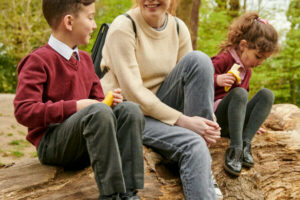Coming out of a pandemic straight into a cost of living crisis can seem like there’s little to be grateful for. And our kids can feel the same way. But if you can bring yourself to practise gratitude with the things you do have, it can improve your mood, lower rates of depression and have a positive and lasting effect on the brain.
This is true for kids as much as adults!
With children’s mental health disorders on the increase, it’s a great time for kids to start practising gratitude.
How do you practise gratitude?
Practising gratitude is about feeling good and positive about what we have in life:
- Some people talk to themselves about their highs and ‘gratitudes’ at the end of the day
- Others find putting pen to paper in a journal makes them more mindful and calm
- Writing gratitude letters to people in your life is a lovely way to express your emotions and let people know they are valued. Even if the letter isn’t sent to that person, the mere act of writing the letter is enough to practise gratitude
- Practising gratitude can even be as simple as making a conscious effort to notice the small lovely things in everyday life. This can involve a ritual to remind you to make a conscious effort. It can be as simple as pausing before you start a meal. Once you consciously notice things you’re grateful for, you can savour them using a ritual like journalling
Make after school fun again
What gratitude does for your brain
Practising gratitude shifts your attention away from negative and harmful emotions, such as jealousy and resentment, and towards the positive. One study showed that participants who practised gratitude for three months had greater activation in their prefrontal cortex in an fMRI scan. The prefrontal cortex is the area of your brain that regulates your emotions, and attention. This can contribute to better mental health in the future as well as in the present. Pretty cool eh? If you make gratitude a habit, you’ll start seeing the benefits after a few weeks.
Helping your kids practise gratitude
Getting your kids into gratitude practise is a great way to improve their wellbeing. Not just right now— it sets them up for the long term.
We think gratitude journals are a perfect way for kids to get into a gratitude practise, which is why we made our own Koru Kids Gratitude Journal.

Our CEO Rachel has been using the journal as a bedtime ritual with her daughter, aged 6. We caught up with Rachel to find out how it’s been going.
“What started as a lovely wind down before bed has turned into a beautiful keepsake. The journal is capturing this moment in my daughter’s life and I love looking back at old entries. My daughter looks forward to writing in it and it’s been a lovely way for her to think about everything she got up to in the day, focus on the positives, and learn how to decompress before bed.”

Regularly, Rachel’s daughter has mentioned the people in her life she was grateful for.
“It’s lovely for her to reflect on these wonderful relationships she has at a time when people can feel so distant. It’s also lovely to send a pic to people she loves, like our nanny. It really made her day.”

To help spread the practise of gratitude we’re giving away a thousand gratitude journals to primary schools for children in years 3-6. Schools have been delighted to receive these as part of their mental health and wellbeing work.



